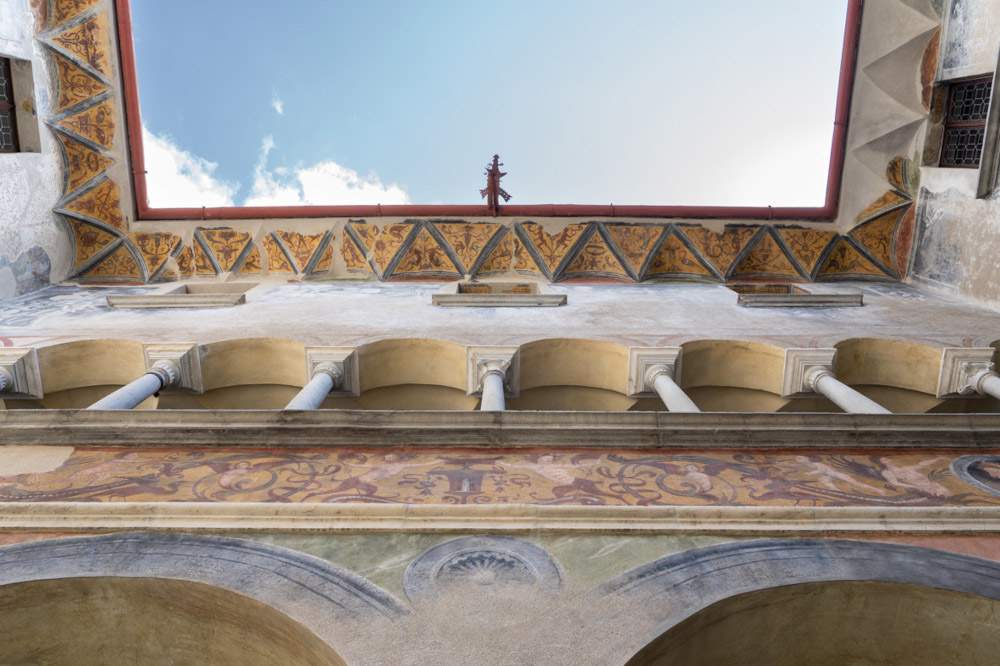Presented yesterday the restoration of the east wall of Teglio’s Palazzo Besta, which involved both the portion of wall paintings dedicated to episodes from the Aeneid and the stone elements, such as columns, capitals, moldings decorative portions, of the eastern wall of the courtyard, in order to define the methodology of intervention for the restoration of the entire courtyard.
Launched in October 2022 and completed at the end of last May, the intervention was funded under the Italy-Switzerland Interreg cooperation project. The Interreg Italy-Switzerland ConValoRe project, with the Municipality of Tirano and Bernina Region as lead partners, aims to strengthen the attractiveness of the territories of Valtellina and Valposchiavo and their common environmental and cultural resources by developing initiatives for the knowledge, conservation, management and sustainable enhancement of natural and cultural heritage.
The restoration was carried out by the company Valeria Galizzi, with Francesca Cardona, and the objectives were, first, to consolidate the pictorial surfaces subject to detachment and lifting, and then to harmonize the overall appearance of the wall, minimizing the marks left by previous interventions, such as old plastering and additions, which made the image fragmentary.
Particular attention was paid to the choice of the final protective coating, which is essential for works intended for outdoor use. It had to guarantee protection, breathability of the masonry, and absence of changes in the colors, and was identified only after comparisons and specific measurements, in agreement with Sonia Segimiro of the competent Superintendency.
“The cycle dedicated to the Aeneid, recently reconfirmed to Vincenzo de Barberis, like all outdoor painting cycles needs constant and constantly updated care,” said Emanuela Daffra, regional director Museums of Lombardy. “This is not a ’revelation restoration’ but rather, if we can coin a new term, ’service’. It aimed at eliminating the causes of degradation and discreetly restoring legibility and a painting made of chromatic contrasts, sketchiness of strokes, liveliness of gestures. For visitors, it will be instructive to compare the wall on which work was done with the others: without screeching, a veil was gently removed and the articulation of the cycle made more legible. This is precisely why the total recovery will be continued with determination.”
Based on the results achieved with the pilot site, the Lombardy Regional Museums Directorate is pursuing the project for the complete restoration of the courtyard. With the work of Giuseppina di Gangi, director of the palace, in-house restorer Valentina Balconi, and with funds from the Ministry of Culture (L.190/2014 annuality 2022-2024), the work will continue on an additional wall as early as September 2023.
The courtyard of honor of Palazzo Besta, of perfectly cubic proportions, is the fulcrum around which the tellina mansion, an example of a Renaissance palace, is developed, at times incorporating buildings from earlier eras. While the building work began in the second half of the 15th century at the behest of Azzo I Besta, it was not until the following century, however, with his son Azzo II and his wife Agnese Quadrio, that the pictorial decoration was completed with cycles of frescoes on biblical, mythological and historical subjects. The palace remained in the Besta family until 1726; later, in the late 19th century, the property was divided among several families and converted into a farmhouse. Purchased by the Italian state in 1911, Palazzo Besta was restored and opened to the public as a museum from 1927.
Sonia Bombardieri, deputy mayor and councillor for Culture and Events, Tourism Development and Integrated Projects, Program Implementation of the Municipality of Tirano-Italian Lead Partner of the Interreg ConValoRe Project, emphasized how relevant the completion of this restoration action is, not only as a project goal but above all as a contribution to the enhancement of the close historical, social and cultural ties between the territories of Valtellina and Valposchiavo, improving the conservation of architectural and landscape heritage, in line with the project objectives of pooling activities, knowledge and methodologies and a strategic vision of preventive and planned conservation, aimed at ensuring the economic and environmental sustainability of cultural heritage, enhancing the attractiveness of the area and enhancing its cultural heritage, especially in terms of tourism.
The partners of ConValoRe, in addition to the Lead Partners Municipality of Tirano and Region Bernina and the Regional Directorate Museums Lombardy, are Valposchiavo Turismo, the World Heritage Society FR - Verein UNESCO Welterbe RhB, the Media Valtellina tourist consortium, the Politecnico di Milano, the University of Milan, the Municipality of Sernio, the Association san Romerio Tirano, Intrecci social cooperative society. The total value of the project is 1,308,832.07 euros and 228,000 Swiss francs with an ERDF (European Regional Development Fund) contribution of 1,112,507.26 euros.
 |
| Teglio, restored east wall of Palazzo Besta |
Warning: the translation into English of the original Italian article was created using automatic tools. We undertake to review all articles, but we do not guarantee the total absence of inaccuracies in the translation due to the program. You can find the original by clicking on the ITA button. If you find any mistake,please contact us.